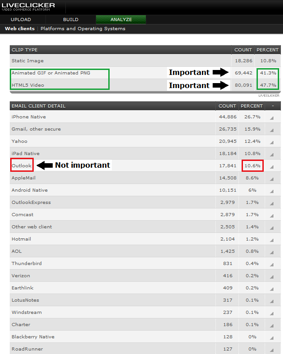Video in Email Part 2: Video in Email Demythified
"For over a decade, marketers were told that the only way to implement video in email campaigns was to include a link in the email pointing to a video playing on a landing page. Placing a video in the email message itself was looked upon as a fool’s errand at best, or the precursor to disastrous deliverability and subscriber experiences at worst. "
For over a decade, marketers were told that the only way to implement video in email campaigns was to include a link in the email pointing to a video playing on a landing page. Placing a video in the email message itself was looked upon as a fool’s errand at best, or the precursor to disastrous deliverability and subscriber experiences at worst.
Today, that’s all changed. We saw in Part 1 of this series that that the belief that video can’t be added directly in the body of the message no longer holds true in an industry that’s shifted dramatically under the advance of HTML5 video support in popular mobile mail clients. In fact, for a marketer to expect 50% of his audience to be able to receive full video (with audio) in email messages is now commonplace; if one includes animated .GIF video to the definition of “video in email,” then that number can reach 90% of all mail recipients capable of viewing video in email.
Yet simply because it’s possible to include video in email, is it a good idea? Before you jump to conclusions, read this list of common video-in-email myths. You might be surprised at what you learn.
Myth: Video in email hurts deliverability.
Fact: Not so. However, you must use the proper technique. The proper technique is to use the HTML5
Myth: Video in email causes rendering problems.
Fact: Today, marketers can deploy a single code snippet in their email campaign to cover 100% of the entire database while ensuring that no one receives a broken experience. Services like the Video Email Express software provided by my company will automatically detect the mail client in use by a mail recipient in real-time, as the message is opened, and dynamically display an asset that’s compatible with the mail client. This ensures that regardless of whether the mail client in use actually supports video, that the recipient will see only something that looks correct inside his mail client.
Myth: Video in email slows down campaign send speeds.
Fact: Video in email will not slow down the send speeds of your campaigns, provided that the videos are referenced in the embed code in the email and not actually delivered with the email itself.
Myth: Video in email isn’t worth pursuing because a handful of mail clients don’t support it.
Fact: This is a common excuse people use to not pursue video in email. Most often cited are the cases of Outlook 2007 and Outlook 2010, neither of which support video in email and will only display static images. What most marketers don’t realize however is that Outlook 2007 and 2010 users only represent about 10% to 12.5% of total mail recipients for B2C sends.
For B2B sends, the proportion is higher, but it rarely exceeds 30%. There are also techniques B2B and B2C senders can use to maximize the percentage of the audience that receives video in email. For example, B2B senders may wish to push their email campaigns outside of working hours, when more of the audience is likely to consume the messages on smartphones or tablets rather than their work desktop client. Since smartphones and tablets are two of the largest spaces where video in email flourishes, this technique can result in substantially higher video in email views, upwards of 25% higher in fact based on our observations.
Why on earth would a B2C sender not want to deploy video in email to 87.5% of his list simply because 12.5% of the audience couldn’t see video? Especially since it’s possible to still deliver a non-broken experience to that 12.5%? If you’re at a loss, then we are on the same page.
Below is an example campaign showing typical results for a B2C sender that’s using all 3 formats: full video in email (via HTML5), animated .GIF/.PNG video, and static images. Notice how full video is 47.7% of the audience, animated .GIF/.PNG video is 41.3%, and static image is 10.8%.

Myth: There’s no point to using video in email because it’s harder to for people to view videos in the email than it is for them to click through to a landing page.
Fact: This myth is really the most “truthy” one of them all. For the iPhone, when video is on a landing page and only referenced via a link in an email, the user must tap the image on his smartphone, wait for the click redirect, wait for a new browser or browser window to load, and again tap on the video to initiate playback (since auto-play is disabled on iPhones). Android, which also disables auto-play by default in the browser, delivers the same results when viewed on a tablet running Honeycomb (note: in other versions of Android, only a static image or animated .GIF version of the video will display in the mail client).
When it comes to webmail clients viewed in an HTML5 compliant browser, the argument that it’s easier to view in the browser than the mail client is stronger, but this argument has big holes, too. For example, all webmail clients (with the exception of Hotmail, which supports HTML5 video, and Gmail, which will add a YouTube video to the bottom of an email message containing a YouTube link), will only display animated .GIF video or static images. Yet animated .GIF videos typically outperform static images for clickthrough between 5% and 15% when A/B tested. Although a click is still required to view the full video on a separate web page in most webmail clients when the user is served either a static image or an animated .GIF video in the mail client, the clickthrough performance of animated .GIFs can be a real ‘win.’ Since most people now access the Internet through broadband, even the lowly animated .GIF can deliver a reasonably high quality video experience in-email, when best practices are followed.
Myth: Video in email isn’t worth pursuing because it will annoy my subscribers.
Fact: Video in email that auto-plays with sound on can annoy subscribers. In tests our clients have run with Video Email Express, auto-playing video in email with sound on drove higher clicks, but also higher unsubscribes. On the other hand, video in email that either auto-played in email with sound off, or required a tap from the user to initiate playback, demonstrated no statistically significant difference in unsubscribe rates.
Myth: Video in email isn’t worth pursuing because it’s hard.
Fact: Like most other skills or technologies, video in email is not hard if you know what you’re doing. You can choose a go-it-alone route which will get you 75% of the way there, by encoding videos in HTML5, coding animated .GIFs, and relying on the fallback approach I outlined. Or, you can rely on a technology like Video Email Express, which will automatically encode several HTML5 videos, animated .GIF/.PNG videos, and static images for the broadest device/browser coverage. Hey, I had to get a plug in here somewhere, I write for free! ;-)
The arguments against video in email are weakening.
As more people embrace mobile devices, marketers will need to deliver content to their audiences in the most user-friendly way possible. With easier access to video in email for smartphone users, we are sure to see more and more senders embracing this technique. Plus, as I’ve communicated today, many of the common beliefs about video in email are really myths. To recount:
- Video in email does not hurt deliverability – if it’s done right.
- Video in email will not cause rendering issues – if it’s done right.
- Video in email will not slow down your campaign send speeds – if it’s done right.
- The fact that Outlook 2007 and Outlook 2010 don’t support video in email is not a strong enough argument to warrant not using video in email, since these mail clients are a relative ‘blip’ on most sender’s lists (especially B2C senders). Even B2B senders can use techniques to minimize the impact of these mail clients without anyone receiving a broken-looking email message.
- Video in email is actually easier for people to view in the mail client on popular mobile devices like the iPhone, iPad, and Android tablets. In webmail clients viewed in desktop browsers (where full video in email isn’t supported in most cases, Hotmail excepted), animated .GIF video can drive higher clickthrough compared to simply using a static image of a video player in the email that’s linked to a landing page player.
- Video in email won’t annoy your subscribers, provided the emails do not arrive in the recipient’s inboxes with sound turned on and the video set to auto-play.
- Video in email isn’t hard, provided you’re willing and able to get your hands a little dirty with some video encoding, or rely on a 3rd party partner to automate the process for you and ensure no one receives anything that looks broken in the email.
Until next time, Happy Selling!
When you subscribe to the blog, we will send you an e-mail when there are new updates on the site so you wouldn't miss them.

 How to resolve AdBlock issue?
How to resolve AdBlock issue? 